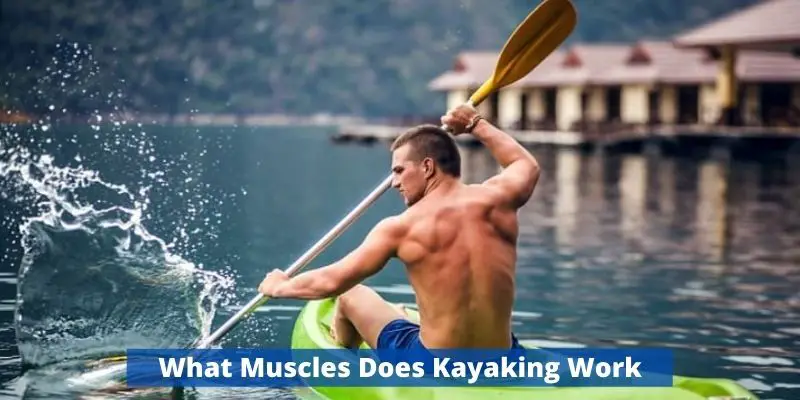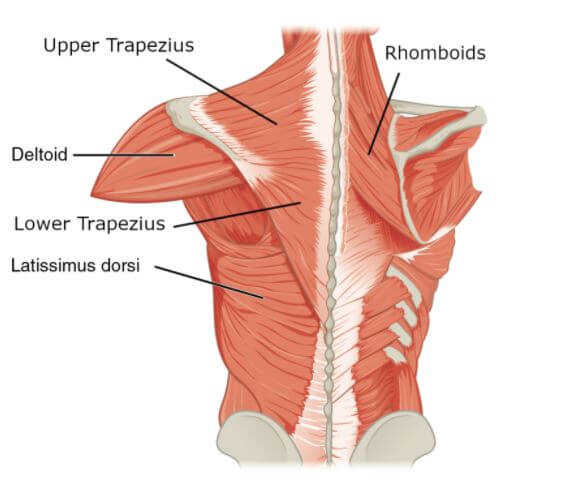Many people love kayaking, as it offers a great way to get outside and explore the wilderness. It’s also an intense upper body workout.
Professional kayakers make it look easy– but paddling is one heck of a good workout. It’s true that your back and arms do most of the work in this activity, but many other large muscle groups are targeted by paddling as well.

Is Kayaking Good Exercise?
Muscles Used In Kayaking
Anyone who has ever kayaked knows that it is a great workout for your back, chest, arms, and shoulders. Kayaking can use more of these muscles in an hour than you would get from any single gym session.
The Back Muscles

Latissimus Dorsi
The Latissimus Dorsi is one of the largest muscles in your back. When rowing on a boat, these are often used and it’s important to have good lats for transferring energy from the lower body into paddling movement. These also work when only extending or contracting inward towards the body; this happens as you row with one arm while using another at times which I find fascinating.
Rhomboid Muscles
The rhomboid muscles are fundamental for kayaking posture. They work to pull the shoulder blades back, towards the spine’s middle at the end of each stroke and are called scapular retraction.
Trapezius Muscles
The trapezius muscles are the unsung heroes of your upper body. You might be able to shrug like nobody’s business, but it takes more than just those “shrug” muscles for a healthy neck and back region. Keep in mind that there is an entire muscle chain running from the shoulder blade area all the way up through our necks; we should prioritize this line as much as we do any other part of our bodies if we want well-rounded development.
To Keep Your Back Comfortable Check Out: Best Kayak Seats
What Muscles Does Kayaking Work In Shoulder Region

Kayaking makes for an intense and highly effective workout. When you begin a stroke, your shoulder is loaded with the weight of both arms because the paddle has to come up from behind each time it dips in front again. Kayakers have found that varying grip widths and using different tempos help them target various muscle groups like their rear delts which are specifically engaged when paddling at medium tempo on narrow grips or wide grips respectively.
Does Kayaking Hit My Chest Muscles?
It may not be evident, but each kayak stroke puts a great impact on your chest muscles. Have you ever done single-arm dumbbell bench presses? Paddling works the same muscles – only in different ways and simultaneously:
Pectorals – a group of muscles that connects to bones at front of the torso and upper arms make up more than half the top part of the body.
Your back muscles are always working with your arms and shoulders, so it’s no surprise that they’re also going to be in the mix during a pull-up. Your chest is bound to get involved as well.
Is kayaking Good For My Arms (Biceps, Triceps, Upper Arms & Grip)
Like any other rowing workout, kayaking will attack the biceps and triceps. During this activity, your grip strength is tested as you maneuver a paddle through the water. Your forearms also get attacked by performing high-rep pullups without letting go of the handle or taking time to rest as most workouts do for breaks in between sets of reps.
Kayaking Strengthens Abs & Core Muscle
The muscles that make up the abdominal wall are responsible for your rotational movements, including kayaking. If you have weak core muscle development and balance in this area then I can guarantee you won’t enjoy anything about a demanding activity like kayaking. Your trunk runs from your waist to neck and is constantly working, rotating with counter-rotating motion as it stabilizes spinal position – making it crucial for good performance.
What About The Lower Body?
Paddling works out your lower body. The reason people think it’s an upper-body workout is that they are using their arms for propulsion, and that gives them the false impression that paddles only involve arm strength. Yes–you do use your legs to stabilize yourself in a kayak, but you’ll also find other ways to work with them as time goes on such as turning, rolling, or bracing during different strokes.
Oh! How Can I Forget That Heart Is A Muscle Too
Kayaking is one of the few cardiovascular exercises that can be performed from a seated position. Kayakers can burn 400-500 calories per hour. There are many benefits from this challenging yet surprisingly fun way to stay healthy.
Guide To: Calories Burnt During Kayaking
Concluding What Muscles Does Kayaking Work
Kayaking is no joke – it’s a great workout and actually makes you feel like less of a lazy man.
Kayakers, prepare to get sweaty in new places. Your whole body will be feeling the burn after one hour on the water: your back muscles, shoulders, chest, arms… basically every muscle that exists? You’ll feel these paddling sessions in those areas plus legs and glutes too (trust me). And don’t forget about how hard your heart works while kayaking; an hour can equal 500 calories burned just from this activity alone.

Hi, I’m Randy R. Lios and the owner of Floating Kayaks. I’ve always been adventuresome at heart. From the time, I got my first kayak at age 18 until now when I have multiple kayaks with accessories and spend 5-6 hours researching all the new related stuff in the market. I have always been fond of fishing since my childhood and kayaking is part of my weekend routine.
